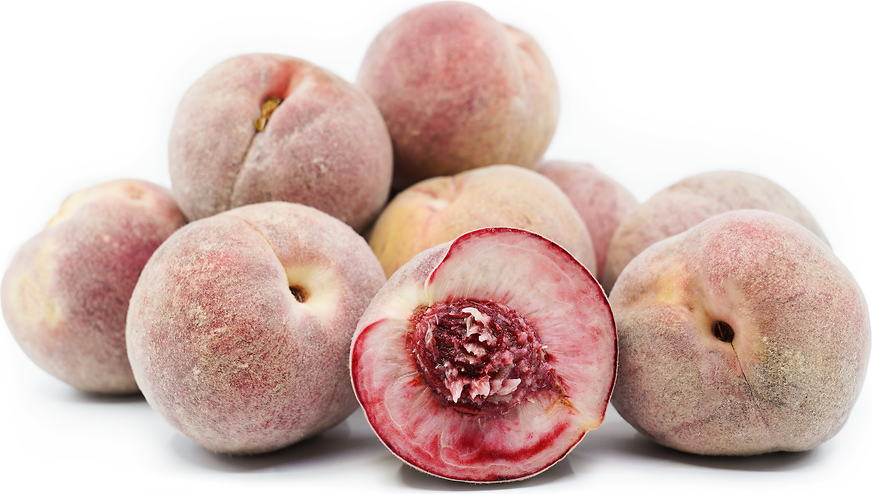


White Blood Peaches
Estimated Inventory, lb : 0
Description/Taste
White blood peaches have a unique appearance. At first, their skin is green and white, dappled with a red blush. As they mature, the fruits will develop a deep red skin. The medium to large-sized peaches are covered by a thick white fuzz, giving the mature fruits a mahogany finish. The peaches give off a rose-like aroma when ripe. Depending on climate and growing conditions, its flesh can range from creamy white with splotches of red throughout and around the pit, to a rich, entirely beet red. The flesh is firm but softens quickly when ripe. White blood peaches offer a sweet flavor with a balance of acidity, and notes of berry and black cherry. Ripe peaches are very juicy.
Seasons/Availability
White blood peaches are available for a short period during the late summer months.
Current Facts
White blood peaches are a rare white-fleshed, blood variety of Prunus persica. They are distinguished from other blood varieties because they are a freestone variety. The heirloom variety is often confused with another blood peach, a clingstone variety with yellow flesh, called “Indian blood”. White blood peaches are not commercially available, and are most often grown by fruit tree enthusiasts and smaller, family-owned orchards. They are sometimes referred to as Iowa White Freestone peaches.
Nutritional Value
Blood peaches are a good source of vitamins A and C. They are rich in minerals such as potassium, fluoride and iron. The stone fruits have antioxidant properties due to high levels of flavonoids and the presence of anthocyanins, the phytonutrients responsible for the red in the skin and flesh of the White blood peach.
Applications
White blood peaches are delicate, but their freestone nature makes them easier to use for salads, baking, or sauces. The red-fleshed peaches offer visual appeal when sliced. They are most often eaten fresh, out-of-hand or in slices. They are ideal for fruit salads and platters, canning, or making into jams and preserves. Use White blood peaches for sorbet, ice cream, or mixed drinks. Blend White blood peaches into smoothies, halve and grill, or bake into pies and tarts. Firm, slightly under ripe peaches can be frozen for later use. White blood peaches will store for up to two weeks in the refrigerator.
Ethnic/Cultural Info
White blood peaches earned the name "Indian Peaches" from the early Americans because they were cultivated by the Cherokee people living in what is now Georgia and the Carolinas. It is believed that peaches were first brought to the Americas in the 16th century by the Spanish when they colonized Mexico. From there, the seeds were diffused by the native peoples as they migrated north into what is now the southern United States. Blood peach varieties are native to only three regions of the world: southeastern China, the Provence and Savoy regions of southeastern France, and the Southeastern United States. Contrary to popular belief, it wasn’t the White blood peach that was grown at Thomas Jefferson’s Monticello. It was the clingstone variety, known as “Indian Blood” that still grows there in the south orchard today.
Geography/History
White blood peaches are likely descendant from the French heirloom freestone, Sanquine de Savoie (Blood of Savoy) peach. They were probably brought to America by the French during the 18th century. The “Indian Blood Freestone” first appeared in Andrew Jackson Downing’s book on American fruit trees in 1869, and is thought to have originated in or around Salem, Massachusetts. Peaches are native to China, and were spread to Europe on the silk trade routes. Blood varieties likely spread to Europe this way, and then were carried to the Americas on ships along with explorers and conquerors. The freestone peach variety tolerates a variety of climates, from the Pacific Northwest to Southern California. The White blood peach trees require another peach or nectarine variety to pollinate its flowers so it will produce fruit. This is the biggest difference between the freestone variety and the similarly named, ‘Indian blood’ clingstone variety. The White blood peach tree is resistant to peach leaf curl, a fungus that affects not only the leaves, but also the blossoms, fruits and shoots of the heirloom peach tree. This is a desirable trait for home growers or small family-run orchards, who may seek out hardier, disease-resistant varieties. White blood peaches are rare, but may be spotted at farmers markets in temperate regions of the United States, Australia, and southeastern France.
Recipe Ideas
Recipes that include White Blood Peaches. One
| Genius Kitchen |
|
Indian Blood Peach and Apple Cake |




